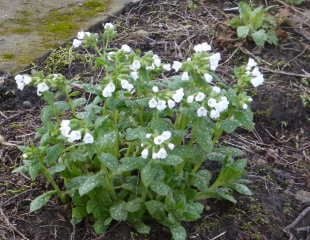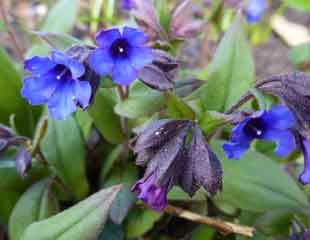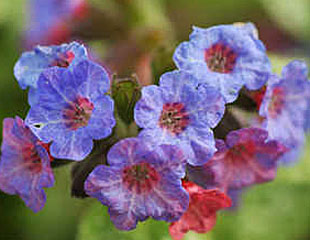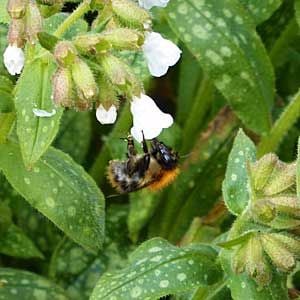


How to Grow Pulmonaria
Pulmonaria, common name Lungwort, is a semi-evergreen, early spring flowering hardy perennial.
Pulmonaria is a woodland plant which like semi shade with moist, well-drained soil. In these conditions, Pulmonaria will thrive and the plants naturally multiply. Because they flower early in the year, late winter/early spring Pulmonaria are attractive to emerging solitary bees, providing much needed early nectar in late February, March and April. Pulmonaria flowers are blue, white, pink and some a combination of both.
Pulmonaria are small plants, up to about 35cms and form clumps around 45cms, ideal for front of borders, ground cover or under-planting shrubs. Some varieties have attractive white spotted leaves such as in the image above and below left of P. 'Sissinghurst White' and also P.'Lewis Palmer', both of which have the RHS garden award of garden merit and P. 'Fruhlingshimmel'
Two of the strongest standout blue forms of Pulmonaria are 'Mawson's blue' and 'Blue Ensign', which is shown in the centre image, both of which have unspotted leaves.
Because Pulmonaria is a plant which likes moist conditions, it is not best suited to growing in container which tend to dry out more quickly that a garden border. If grown in a container, Pulmonaria would benefit from a mulch to help retain water, possibly some water retaining gel and the container would need to be placed in semi shade conditions.
When to cut back Pulmonaria
Pulmonaria is best cut back after flowering when they can look a bit scruffy, especially if grown in less than ideal conditions. Mildew can be a problem over the warmer months. To tidy up the plant and discourage mildew, cut back the old leaves when flowering has finished around April time. Cut off all the old tired leaves and then water well and the plant will reward with new growth and flowers next winter.
Pulmonaria will show a new growth of leaves in the summer. Like Hellebores, the old leaves on Pulmonaria lay at the base of the plant with the new growth in the centre. If the old growth is shabby, it can be cut off near the ground, leaving the new fresh foliage uppermost.
Whether it necessary to cut the leaves on Pulmonaria often depends on its growing conditions. In ideal conditions, a woodland setting with shade, the leaves often remain fresh and the Pulmonaria will grow with no attention or maintenance. If grown in a sunny dry spot, the old leaves will often need cutting back.

Pulmonaria is an easy plant to grow, flowering reliably each spring with very little attention.
Pulmonaria is good for Bees

For me, a good reason to grow Pulmonaria is to provide a source of nectar for early foraging bees, such as hungry queen bumblebees. Pulmonaria attracts solitary bees, as in the image left showing a bee, early in the season on a P. 'sissinghurst white'. Pulmonaria are not a showy plant, relatively low growing with small flowers but they are a useful addition to a wildlife friendly garden because they are one of the few plants flowering in February and March and which specifically attract solitary bees and the hairy-footed bee.
How to propagate Pulmonaria
Pulmonaria self seed, although not so much as to be a nuisance and it is easy to remove unwanted seedlings.
If you want plants true to the colour of the parent plants, which is not often the case with seedlings, it is better to divide them and Pulmonarias grow better if divided every 5 years, although it is not essential to do so. To divide Pulmonarias, after flowering trim back spent leaves and then lift the clump with a fork, and shake off soil so the roots can be seen. Divide up the clump and re plant watering well. They are very easy to divide and make have new plants for free.
Pulmonarias are easy to grow, although they are prone to mildew, and if this happens, cut off all infected leaves and if extensive cut plant down to ground level; it will regrow.
Pulmonarias are a good source of early nectar for the solitary bees as they emerge and forage for food. For more information check out wildlife friendly plants and plants for bees and butterflies.
